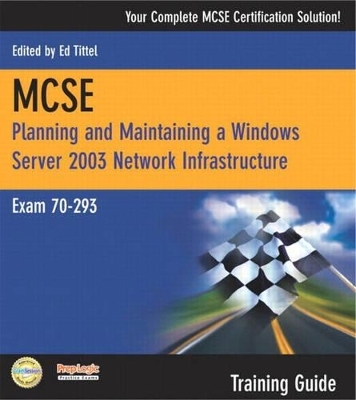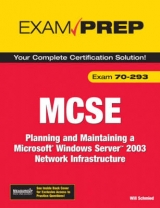
MCSE 70-293 Training Guide
Pearson IT Certification
978-0-7897-3013-8 (ISBN)
- Titel erscheint in neuer Auflage
- Artikel merken
Will Schmied (BSET, MCSE, CWNA, TICSA, MCSA, Security+, Network+, A+) is the president of Area 51 Partners, Inc., a provider of wired and wireless networking implementation, security, and training services to businesses in the Hampton Roads, Virginia, area. Will holds a bachelor's degree in mechanical engineering technology from Old Dominion University, along with his various IT industry certifications. In addition to his activities with Area 51 Partners, Inc., Will operates the MCSE certification portal MCSE World located at http://www.mcseworld.com. Will has previously authored and contributed to several other publications from Que Publishing, including MCSA/MCSE Planning, Implementing, and Maintaining a Microsoft Windows Server 2003 Environment Exam Cram 2 (Exam 70-296); MCSA/MCSE 70-291 Training Guide: Implementing, Managing, and Maintaining a Windows Server 2003 Network Infrastructure (2003); MCSA Training Guide (70-218): Managing a Windows 2000 Network Environment (2002); MCSE Windows 2000 Server Exam Cram 2 (Exam 70-215) (2003); Special Edition Using Windows XP Professional, Bestseller Edition (2003); and Platinum Edition Using Windows XP (2003). Will has also worked with Microsoft in the MCSE exam-development process. Will currently resides in Newport News, Virginia, with his wife, Chris; their children, Christopher, Austin, Andrea, and Hannah; their dogs, Peanut and Jay; and their cat, Smokey. When he's not busy working, you can find Will enjoying time with his family or reading a Douglas Adams book. You can visit Area 51 Partners at http://www.area51partners.com. Robert J. Shimonski (TruSecure TICSA, Cisco CCDP, CCNP, Cisco Firewall Specialist, Nortel NNCSS, Microsoft MCSE, MCP+I, Novell Master CNE, CIP, CIBS, CNS, IWA CWP, DCSE, Prosoft MCIW, SANS GSEC, GCIH, CompTIA Server+, Network+, Inet+, A+, e-Biz+, Security+, HTI+, Symantec SPS, and NAI Sniffer SCP) is a Lead Network and Security Engineer for a very large conglomerate. Robert has planned, designed, maintained, and managed very large network infrastructures for more than 50 companies around the world. Solutions deployed include but are not limited to Cisco and Nortel routing and switching equipment, Check Point and Cisco Security solutions, Microsoft and Novell Directory deployments, and many others. Robert's specialties include network infrastructure design with the Cisco and Nortel product line; network security design and management with CiscoSecure and PIX firewalls; network management and troubleshooting with CiscoWorks, CiscoSecure, and Sniffer-based technologies. Robert is the author of many security-related articles and more than 25 published books, including the Sniffer Network Optimization and Troubleshooting Handbook and the Security+ Study Guide and DVD Training System. You can contact Robert at http://www.rsnetworks.net or at rshimonski@rsnetworks.net.
Introduction.
Study and Exam Prep Tips.
Learning Styles. Study Tips. Exam Layout and Design. Question-Handling Strategies. Mastering the Inner Game. Final Considerations.
1. Planning and Implementing Server Roles and Server Security.
Introduction. Implementing Enterprise Security. Planning Secure Baseline Installations. Planning and Implementing Role-Based Security Using Security Templates.
2. Planning, Implementing, and Maintaining a Network Infrastructure.
Introduction. Planning a TCP/IP Network Infrastructure Strategy. Analyzing IP Addressing Requirements. Planning an IP Routing Solution. Planning and Modifying a Network Topology. Planning for Network Traffic Monitoring. Troubleshooting TCP/IP Addressing. Planning and Troubleshooting Internet Connectivity.
3. Planning, Implementing, and Maintaining a Name Resolution Infrastructure.
Introduction. Introduction to DNS. Planning a DNS Namespace Design. Planning DNS Zone Requirements. Planning DNS Forwarding Requirements. Configuring DNS Security. Integrating with Third-Party DNS Solutions. Introduction to WINS. Implementing WINS Replication. Implementing NetBIOS Name Resolution. Troubleshooting Name Resolution Problems.
4. Planning, Implementing, and Maintaining Routing and Remote Access.
Introduction. Planning a Routing Strategy. Planning Routing for IP Multicast Traffic. Planning and Implementing Remote Access Security. Troubleshooting TCP/IP Routing. Troubleshooting OSPF Environments.
5. Planning, Implementing, and Maintaining Highly Available Servers.
Introduction. Designing for High Availability. Planning High Availability Solutions. Planning and Implementing NLB Clusters. Planning and Implementing MSCS Clusters. Monitoring and Managing High Availability Solutions.
6. Monitoring and Maintaining Server Availability.
Introduction. Monitoring System Performance for Bottlenecks. Planning Backup and Recovery Operations.
7. Planning and Maintaining Network Security.
Introduction. Planning Secure Remote Administration Methods. Planning Wireless LAN (WLAN) Security. Planning Security for Data Transmission.
8. Planning, Implementing, and Maintaining Security Infrastructure.
Introduction. What's New in Windows Server 2003 Certificate Services? Planning a Windows Server 2003 Public Key Infrastructure (PKI). Planning and Implementing a Security Update Infrastructure. Planning a Security Framework.
Fast Facts.
Planning and Implementing Server Roles and Server Security. Planning, Implementing, and Maintaining a Network Infrastructure. Planning, Implementing, and Maintaining a Name Resolution Infrastructure. Planning, Implementing, and Maintaining Routing and Remote Access. Planning, Implementing, and Maintaining Highly Available Servers. Monitoring and Maintaining Server Availability. Planning and Maintaining Network Security. Planning, Implementing, and Maintaining Security Infrastructure.
Practice Exam.
Exam Questions Answers and Explanations
Appendix A: Glossary.
Appendix B: What's on the CD-ROM?
PrepLogic Practice Exams, Preview Edition.
Appendix C: Using PrepLogic, Preview Edition Software.
Exam Simulation. Question Quality. Interface Design. Effective Learning Environment. Software Requirements. Installing PrepLogic Practice Exams, Preview Edition. Using PrepLogic Practice Exams, Preview Edition. Get More Exams. Customer Service.
Index.
| Erscheint lt. Verlag | 24.12.2003 |
|---|---|
| Verlagsort | Upper Saddle River |
| Sprache | englisch |
| Gewicht | 1356 g |
| Themenwelt | Informatik ► Betriebssysteme / Server ► Windows |
| Informatik ► Betriebssysteme / Server ► Windows Server | |
| ISBN-10 | 0-7897-3013-8 / 0789730138 |
| ISBN-13 | 978-0-7897-3013-8 / 9780789730138 |
| Zustand | Neuware |
| Haben Sie eine Frage zum Produkt? |
